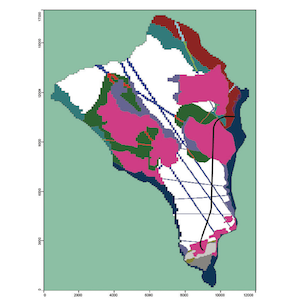Parametric and numerical modeling tools to forecast hydrogeological impacts of a tunnel

All claims expressed in this article are solely those of the authors and do not necessarily represent those of their affiliated organizations, or those of the publisher, the editors and the reviewers. Any product that may be evaluated in this article or claim that may be made by its manufacturer is not guaranteed or endorsed by the publisher.
Authors
The project of interest involving a hydroelectrical diversion tunnel through a crystalline rock massif in the Alps required a detailed hydrogeological study to forecast the magnitude of water inflows within the tunnel and possible effects on groundwater flow. The tunnel exhibits a length of 9.5 km and is located on the right side of the Toce River in Crevoladossola (Verbania Province, Piedmont region, northern Italy). Under the geological framework of the Alps, the tunnel is located within the Lower Penninic Nappes in the footwall of the Simplon Normal Fault, and the geological succession is mostly represented by Antigorio gneiss (meta-granites) and Baceno metasediments (metacarbonates). Due to the presence of important mineralized springs for commercial mineral water purposes, the abovementioned hydrogeological study focused on both quantity and quality aspects via rainfall data analysis, monitoring of major spring flow rates, monitoring of hydraulic heads and pumping rates of existing wells/boreholes, hydrochemical and isotopic analysis of springs and boreholes and hydraulic tests (Lefranc and Lugeon). The resulting conceptual model indicated dominant low-permeability (aquitard) behavior of the gneissic rock masses, except under conditions of intense fracturing due to tectonization, and aquifer behavior of the metasedimentary rocks, particularly when interested by dissolution. Groundwater flow systems are mainly controlled by gravity. The springs located near the Toce River were characterized by high mineralization and isotopic ratios, indicating long groundwater flow paths. Based on all the data collected and analyzed, two parametric methods were applied: 1) the Dematteis method, slightly adapted to the case study and the available data, which allows assessment of both potential inflows within the tunnel and potential impacts on springs (codified as the drawdown hazard index; DHI); 2) the Cesano method, which only allows assessment of potential inflows within the tunnel, thereby discriminating between major and minor inflows. Contemporarily, a groundwater flow model was implemented with the equivalent porous medium (EPM) approach in MODFLOW-2000. This model was calibrated under steady-state conditions against the available data (groundwater levels inside wells/piezometers and elevation and flow rate of springs). The Dematteis method was demonstrated to be more reliable and suitable for the site than was the Cesano method. This method was validated considering a tunnel through gneissic rock masses, and this approach considered intrinsic parameters of rock masses more notably than morphological and geomorphological factors were considered. The Cesano method relatively overestimated tunnel inflows, considering variations in the topography and overburden above the tunnel. Sensitivity analysis revealed a low sensitivity of these parametric methods to parameter values, except for the rock quality designation (RQD) employed to represent the fracturing degree. The numerical model was calibrated under ante-operam conditions, and sensitivity analysis evaluated the influence of uncertainties in the hydraulic conductivity (K) values of the different hydrogeological units. The hydraulic head distribution after tunnel excavation was forecasted considering three scenarios, namely, a draining tunnel, tunnel as a water loss source, and tunnel sealed along its aquifer sectors, considering 3 levels of K reduction. Tunnel impermeabilization was very effective, thus lowering the drainage rate and impact on springs. The model quantitatively defined tunnel inflows and the effects on spring flow at the surface in terms of flow rate decrease. The Dematteis method and numerical model were combined to obtain a final risk of impact on the springs. This study likely overestimated the risk because all the values assigned to the parameters were chosen in a conservative way, and the steady-state numerical simulations were also very conservative (the transient state in this hydrogeological setting supposedly lasts 1–3 years). Monitoring of the tunnel and springs during tunnel boring could facilitate the feedback process.
How to Cite

This work is licensed under a Creative Commons Attribution-NonCommercial 4.0 International License.
PAGEPress has chosen to apply the Creative Commons Attribution NonCommercial 4.0 International License (CC BY-NC 4.0) to all manuscripts to be published.














